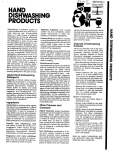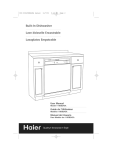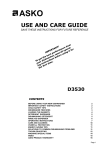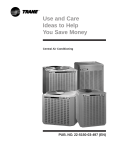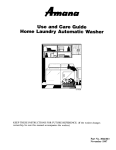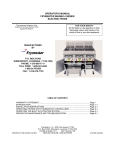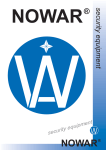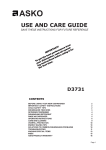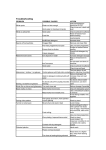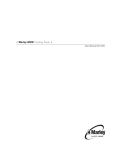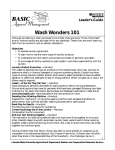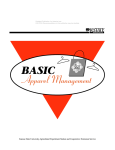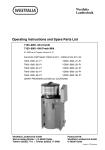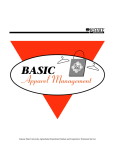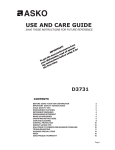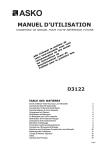Download HAND DISHWASHING - Lawtongroup.com
Transcript
HAND DISHWASHING HAND DISHWASHING PRODUCTS Dishwashing is probably subject to more variables than any other household clean-up job. In theory at least, any detergent or soap can be used for hand dishwashing, except an automatic dishwasher detergent. However, soap has become almost extinct as a dishwashing product and many laundry detergents are not very acceptable. Laundry detergents may leave spots and streaks, the powders may not completely dissolve, or may discolor certain metals with soaking. A light-duty, liquid hand dishwashing detergent is the best choice. LIQUID HAND DISHWASHING DETERGENTS Regardless of brand, certain characteristics are important in a hand dishwashing liquid: lasting suds, effective cleaning performance, mildness to hands, safety for dishes and other washables, storage stability, pleasant fragrance and appearance, convenient packaging and dispensing. In formulating a product to meet these criteria, manufacturers, in general, use certain basic ingredients. Ingredients Surfactants or surface active agents are the primary ingredients in a liquid hand dishwashing detergent. Often a combination of surfactants is used to produce good greasecutting capability and soil suspension, mildness in water of varying degrees of hardness, and a high, stable suds level. All surfactants in these detergents are biodegradable. Stability and Dispensing Aids are added to keep the product homogeneous under varying storage conditions, and to provide desirable dispensing characteristics. Alcohols, hydrotropes, and salts are often used. SDA 2000 Fragrance and Color Additives are what give a product its “personality,” and are important, though present in extremely small amounts. Mildness Additives may include moisturizing agents, certain oils and emollients, certain protein compounds, or other neutralizing or beneficial ingredients. Preservatives are added, if needed, in small quantities to help prevent any microbiological growth in the product which could cause color or odor change, poor performance, and separation of the ingredients. Antibacterial Agents are sometimes added to provide antibacterial protection for the hands. Performance Factors Hand dishwashing liquids are relatively easy for consumers to compare. Users can experiment by trying various brands and deciding which product feaures are important to them . . . performance, price, sudsing, fragrance, and “feel,” or perhaps the packaging. Usage is often based on the amount it takes to produce a rich, thick layer of suds. Though detergents are not as affected by water hardness as soap is, some additional product may be necessary in very hard water. An important difference in the quantity of liquid hand dishwashing detergent required is the concentration of the surfactants vs. water in a product. More concentrated products are more efficient and may be mor e economical to use than the more dilute ones. Grease removal is more effective in warm water than in cold water. DISPOSAL OF HAND DISHWASHING DETERGENTS Just as you exercise care in the manner in which you use and store other household cleaning products, you should properly dispose of empty dishwasher detergent containers or small amounts of leftover products by following some simple procedures. ■ Get the most for your money — USE THE PRODUCT UP! If you find you cannot use all of the product you purchased, give it to a friend, but make sure the label with directions and precautions is still legible. ■ Check the label for special instructions for disposal. Unused hand dishwashing detergents can be disposed down the drain. Many communities recycle the empty plastic containers. Check your local recycling guidelines and recycle containers when possible. ■ Don't mix products when disposing of them. ■ NEVER reuse an empty dishwashing detergent container for another purpose. The label instructions and precautions for one product may be dangerous to someone trying to use those instructions for a different product. READ ALL LABELS THOROUGHLY AND USE PRODUCTS ONLY FOR INTENDED PURPOSES AND AS DIRECTED. OTHER CLEANERS See Household Cleaning Fact Sheet Notebook for information on metal cleaners and sink cleaners. This can be ordered from The Soap and Detergent Association. 1 The Soap and Detergent Association 1500 K Street, NW Washington, DC 20005 © 2000 The Soap and Detergent Association HAND DISHWASHING HAND DISHWASHING PROCEDURES Washing dishes by hand is a fairly simple process and results are very obvious. However, a routine and some organization help get the job done quickly and efficiently. EQUIPMENT AT THE SINK Plastic Dishpan: A square, round or rectangular dishpan is helpful when a double sink is not available. Choose a size that leaves part of a single sink accessible for scraping or prerinsing dishes. A dishpan can be emptied and refilled quickly with hot water and detergent as needed. It has a softer surface than a sink, and breakage is less likely. Rubber Mat: When washing directly in a sink, a mat helps cushion the bottom and reduces breakage. Drain Rack: Made of plastic-coated wire, formed plastic or, occasionally, wood, racks are almost essential for draining rinsed dishes. With a drain tray under the rack to catch rinse water, dishes can be rinsed right in the rack with extra-hot water from a spray hose, pitcher or pan. When there’s a second sink large enough to hold a drain rack, no drain tray is necessary except perhaps for pans and other utensils. After a hot rinse, most dishes will air dry without wiping, saving a step. Cups, bowls, mugs and glasses need to be rinsed inside by immersion or under running water, then racked upside down for final rinsing. Scrapers: A flexible plastic or rubber scraper can be used to quickly remove loose food soils from plates, casseroles and pans. Careful scraping largely eliminates any prerinsing of dishes. Scrubbers: To remove crusty or hard residues, a wide variety of scrubbers is available. Plastic mesh, metal mesh, rough-surfaced sponges and cloths, steel wool soap pads and brushes all have their devotees. SDA 2000 Some plastic mesh and roughtextured sponges are gentle enough for scrubbing more delicate sufaces, such as nonstick pan finishes, shiny metals or china. Others are strictly heavy duty, and labels usually include cautions. Steel wool soap pads do an excellent job of removing discoloration and film from aluminum utensils, leaving them shiny. Rubber Gloves: Gloves are helpful for hands sensitive to hot water, to minimize fingernail damage when scrubbing, and to give a better grip when washing breakable pieces. Dishcloths, Sponges, Dishmops: These provide the basic washing action as each item is wiped clean with the detergent solution, all sides, inside and out. Each type has its advantages, but they all do the job. Dishtowels: In addition to the traditional cotton towel, nonwoven fiber cloths and even paper towels can be used to dry dishes, glassware, flatware and pans that are not air dried. Avoid a lintshedding material. Detergents and Special Cleaners: Liquid hand dishwashing detergents needed at the sink are described in “Hand Dishwashing Products.” GETTING ORGANIZED Clear a space on the counter next to the sink to stack scraped and/or prerinsed dishes. Flatware can be soaked briefly in a detergent solution. If any pots, pans or bakeware have been soaking in the sink during the meal, wash them first. Drain this soiled water away and use clean hot water and detergent for the table service items and any remaining cookware. Dirty dishes can be stacked on trays, then moved to the sink area as space becomes available. In most kitchens, it’s helpful to place the drain rack on the side of the sink that is nearer dish storage; stack dirty dishes on the opposite side. 2 Soaking Wipe off any leftover food and grease from dishes and cookware using a rubber spatula or paper towels. Never pour grease down the drain; this can cause the drain to clog. Soak dishes with greasy soils or stubborn baked-on or burned-on foods. To do this, add liquid hand dishwashing detergent or baking soda to the soiled utensils, then fill with hot water. If there are a number of items that need soaking, use a dishpan. Soak about 15 to 30 minutes or during the meal. Then drain the water and wash the dishes and cookware. Some automatic dishwasher detergents may be appropriate for soaking burned-on foods. Be sure to check the label first. Washing, Rinsing, Drying First fill the dishpan or sink with water as hot as can be comfortably used, and add enough detergent as the water is running to produce a thick, rich layer of suds. If rinsing in a separate sink or dishpan, fill it with very hot water. Washing: Using clean, hot water and detergent, start with the lightly soiled items, generally glassware and flatware, followed by plates of various sizes, serving dishes, and finally any remaining cookware not previously washed. Change the dishwashing solution if it becomes greasy, too cool, or if the suds disappear. Otherwise, film and soil will not be completely removed. Handle kitchen knives carefully by their handles; don’t pile them into the sink or dishpan, but wash them one by one and rack them with handles up. There are several ways to wash dishes. Some people prefer to lift each piece out of the suds to wipe it with cloth or sponge, others like to keep dishes beneath the suds surface so soil floats away. Some stack dishes in the sink or dishpan, others like to take each piece from the counter, wash it and take another. HAND DISHWASHING Rinsing: The hotter the rinse water, the faster dishes will air dry. After racking dishes, pour or spray hot water over them if they haven’t been dipped in a rinsing sink or pan. Rinse inside cups, bowls and glassware. Drying: Air drying is easier than towel drying, and may be more sanitary than drying with a soiled towel. However, wiping with a clean towel is particularly useful when glassware or flatware is spotted or filmed. Buffing silverware with a soft, clean, lint-free cloth actually improves its patina. Paper towels are handy for wiping pots and pans, especially any that may leave traces of grease or discoloration on a cloth towel. SPECIAL TIPS FOR HAND DISHWASHING ■ When scraping dishes, put food scraps into a plastic bag, garbage disposal, in the sink or directly into a kitchen waste can lined with a bag. Very wet garbage can be drained first in a colander set in the sink, then discarded into a garbage can. Use an empty food can to collect excess grease, pan drippings, or any kind of wet waste. ■ Do not soak cast iron utensils. To retain their “seasoning” and discourage rusting, wash in hot water using a sponge or cloth. Scour stubborn stains with a steel wool soap pad rather than soaking in detergent which removes the built-up fat that seasons the utensil. Rub vegetable oil on any scoured areas to reseason. Dry pans briefly over heat on the range to prevent rusting from moisture. ■ Do not soak aluminum utensils for excessive periods of time, as exposure to water can cause aluminum to darken. ■ Change the dishwashing solution and rinse water when they cool down or before they become noticeably greasy. ■ Clean greasy pan bottoms as well as the insides. If a grease film remains, the bottom will blacken when the pan is used again. ■ Nonstick finishes on pans need a thorough cleaning to retain non-stick performance. Use a plastic mesh scouring pad designed for cleaning nonstick surfaces, a “light duty” plasticcoated sponge, or sprinkle baking soda on the bottom of the pan and gently scrub. Use plenty of hot water and detergent to remove any greasy film. ■ Oven-glass casseroles and dishes can show cloudy areas even when clean. This is usually a food film of protein origin (milk, cheese, egg, meat juice). Rubbing with a sponge or cloth and white vinegar will usually remove the film. ■ When there is illness in a family, such as colds, flu or a communicable disease, doctors often recommend a degree of isolation and use of disposable eating utensils. While careful dishpan practices can help home sanitation, and clean dishes are seldom the carriers of disease organisms, do follow doctor’s advice. A 5-minute soak (after washing) in a solution of 1 tablespoon (15 ml) liquid household (sodium hypochlorite) bleach to 1 gallon (3.8 L) of water should kill household germs. This method is not recommended for silver flatware which may tarnish. CAUTION: Because of the variety of ingredients in hand dishwashing detergents, check with the detergent manufacturer before mixing sodium hypochlorite bleach and hand dishwashing detergents. Some formulations contain ingredients that are incompatible with the bleach and hazardous gases may be released. The Soap and Detergent Association 1500 K Street, NW Washington, DC 20005 © 2000 The Soap and Detergent Association SDA 2000 3 ENERGY MANAGEMENT IN HAND DISHWASHING Apart from the human energy required to wash dishes and utensils, the major use of fuel is to heat water for washing. Individual habits of water usage vary greatly. However, higher usage and/or shortages of incoming cold water supply are important factors in encouraging efficient use for all household purposes. Of all the uses, dishwashing is one where no compromise in cleanliness is acceptable. Hot water is essential for both hand and machine dishwashing. Savings in Hand Dishwashing Estimates of water usage for hand dishwashing range from 9 to 24 gallons (34.2 to 91.2 L) per meal, part of which is cold water. This wide range indicates not only household variations, but differing procedures. Undoubtedly, water temperatures vary greatly. Washing dishes, and particularly greasy utensils, in water less than 90 O F (33 O C), even with sufficient detergent, is likely to leave a greasy film. The hottest water most people's hands can tolerate is about 110O F (43.30O C). Keeping dishwashing water as close as possible to this upper limit will provide good results. Conserve water by reducing water quantity rather than temperature. Some Sensible Ways to Conserve Energy ■ Presoak especially difficult cooked-on soils. ■ Scrape away food residues and heavy grease. ■ Wash lightly soiled items first and more heavily soiled items later. Change the washing solution when it cools down or becomes greasy or dirty. ■ Wash in a sink or dishpan of hot suds, rather than under running water, even for a few dishes. ■ Rinse by dipping each item in a pan of hot water, or by racking dishes and spray-rinsing. Avoid running hot water continuously for rinsing. ■ Accumulate dishes, rather than running hot water for a few items. Soaking will soften food soils. The Soap and Detergent Association 1500 K Street, NW Washington, DC 20005 © 2000 The Soap and Detergent Association SDA 2000 4 H AND DISHWASHING PROBLEMS, CAUSES and SOLUTIONS PROBLEM CAUSES SOLUTIONS Gray or metal marks on dinnerware Knife or fork drawn across the surface of some types of dinnerware, generally the stronger, harder ceramic materials. Scour gently with mild abrasive cleanser, baking soda or plastic mesh pad. A spoon used to stir in a stoneware cup. Same as above. Wash water temperature too low. Increase water temperature and rinse thoroughly in hot water. Insufficient amount of detergent. Increase amount of detergent. Burned-on food in pans Cooking at too high a temperature or too long a time. Bring a solution of baking soda and water (3 tablespoons in 1 quart) to a boil in the soiled pan. Remove from heat and add 1 tablespoon liquid hand dishwashing detergent and allow to cool. If soil remains, scrub with baking soda sprinkled on a plastic scouring pad or sponge; rinse and dry. Baked-on food in casseroles, other bakeware of glass or glass-ceramic material Cooking certain types of food, such as those containing cheese, gravies, eggs or pie fillings. Scour gently with mild abrasive cleanser, baking soda or plastic mesh pad. Spots and film on glassware Soak in a solution of liquid hand dishwashing detergent and/or baking soda and water to loosen soil. Do not use any automatic dishwasher detergent product for hand washing unless recommended by the product manufacturer. Do not use metal scouring pads as they may scratch the surface. Coffee, tea stains on plastic or china cups Cups not rinsed and washed soon after using. Use a special cleaner made for coffee pots and cups, or a solution of 1 tablespoon (15 ml) liquid or powdered sodium hypochlorite bleach in 1 quart (0.95 L) of water. Certain oxygen bleaches can be used. Follow label directions. Another method is to sprinkle baking soda onto a damp cloth or sponge, rub surface until clean; rinse and dry. Avoid the use of an abrasive cleanser which may abrade the surface and make the cups more subject to stains. Darkened aluminum Exposure to certain minerals and alkalis in some foods and water. Boil a solution of 2 to 3 tablespoons (30 to 45 ml) of cream of tartar, lemon juice or vinegar to 1 quart (0.95 L) of water in the utensil for 5 to10 minutes. Then lightly scour with a steel wool soap pad. Cooking an acid food, such as tomatoes, will also remove the stains and will not affect the food. Clean with a metal cleaning product recommended for use on aluminum. Follow package directions. Staining of nonstick cookware Minerals in water, baked-on fat, food stains or the use of excessive heat. Use any one of the following solutions: To 1 quart (0.95 L) of water, add 1/4 cup (60 ml) coffee pot cleaner. Or To 1 cup (240 ml) of water, add 3 tablespoons (45 ml) of oxygen bleach. Let the solution simmer in the stained pan for 15 to 20 minutes. Wash the pan thoroughly, rinse and dry. Then recondition the pan with cooking oil or shortening before using. The Soap and Detergent Association 1500 K Street, NW Washington, DC 20005 © 2000 The Soap and Detergent Association To prevent staining, use the lowest heat that will do the job. AUTOMATIC DISHWASHING AUTOMATIC DISHWASHING PRODUCTS DETERGENTS Automatic dishwasher detergents provide the chemical energy to help remove food soil from all types of cooking and serving items. Unlike hand dishwashing products, these must be very low to nonsudsing. Suds interfere with the mechanical cleaning action of the water and result in suds overflow from the machine. In addition, automatic dishwasher detergents should inhibit foam that certain proteincontaining foods, such as egg and milk, create. They must soften water to prevent insoluble deposits, loosen and hold soil in suspension, leave items clean and grease-free so they rinse and dry without spots, and be safe for a wide variety of dishes, glassware, utensils, etc. Forms Today’s automatic dishwasher detergents are available in three forms: powders, gels and tablets. All forms perform well, so the choice is usually made on personal preference. Powders are free-flowing granules. Most people are familiar with powders as they are the traditional automatic dishwasher detergent form. Gels are formulated to provide controlled dispensing. Because of their form, they are less likely to be spilled than powders. Gels dissolve quickly, allowing the detergent to begin working right away. Tablets are formulated for effective cleaning as well as convenience. Since they are pre-measured, there is no measuring, waste or mess. One tablet contains the exact dose for a full load. Each tablet may be individually wrapped to protect it from moisture, humidity and to extend its shelf life. SDA 2000 Although tablets are formulated to work in all types of water, you may need to use an extra tablet in extremely hard water. Depending on their formulation and product form, automatic dishwasher detergents may contain the following ingredients: Ingredients Surfactants or surface active agents loosen soil and emulsify fats, help hold them in suspension, and leave surfaces clean and free from spots and film. Specially developed surfactants having the lowest sudsing characteristic are used. Phosphates tie up water hardness minerals (primarily calcium and magnesium) so the minerals won’t interfere with cleaning or deposit on surfaces. Phosphates also help keep food soil particles in suspension after removal from the soiled surfaces and prevent their redeposition. Chlorine or Oxygen Bleaches are added to help prevent spots by leaving a cleaner surface than would be obtained with either surfactants or phosphates alone. The very small amount of bleach helps break down protein soils and aids in removing stains such as coffee or tea. A Corrosion Inhibitor, such as sodium silicate, helps provide protection for the dishwasher and the wide variety of materials that are washed. Some materials still should not be washed in the automatic dishwasher (see Automatic Dishwashing Procedures). The corrosion inhibitor is also a soil suspending agent and an important source of alkalinity. Enzymes are naturally occurring proteins that help break down food and soil residue into small particles. The small particles are then washed away. 5 Special Additives , such as sodium aluminate, boric oxide or aluminum phosphate, may be used to inhibit the removal of overglaze and pattern from fine china. Sometimes antifoams are added to reduce sudsing. Additional Alkalis , such as sodium carbonate, sodium hydroxide or trisodium phosphate, may be used to aid in handling greasy food soils. Polymers help prevent film buildup from hard water. Thickening Agents are used in gel automatic dishwasher detergents so the product remains in the dishwasher cup(s) until automatically dispensed at the appropriate time. Colorants are added to lend individuality and an appealing appearance to the product. Processing Aids , generally inert materials, allow the active ingredients to be combined into a usable form. Fragrance covers the chemical odor of the base product and stale food odors that might come from the dishwasher. Specialty products are also available to help prevent or correct problems. SPECIALTY PRODUCTS Rinse Agents are formulated to lower the surface tension of the water, causing it to sheet off the dishes. A rinse agent helps a dishwasher rinse away residues that cause spots and film. Rinse agents are helpful for obtaining dry dishware when dishwasher energy saving cycles are used, or when dishes are left to air dry. Liquids are available for use in dishwashers with a built-in rinse reservoir and dispenser. Solid forms are made to attach to the upper dishwasher rack, where they slowly dissolve and contribute to each water change in the cycle. AUTOMATIC DISHWASHING Film Removers are powdered alkaline products containing chlorine and complex phosphates. They can be used to remove build-up of hard water film and cloudiness on dishes and the interior of the dishwasher. The film remover is used in place of an automatic dishwasher detergent in a separate cycle, or combined with the dishwasher detergent. Some dishwasher manuals may suggest the use of white vinegar or citric acid crystals to remove film and stains. When using any product not specifically made for dishwasher use, it is very important to follow the dishwasher manufacturer’s instructions precisely and not substitute or vary the procedures. Make certain the product is safe for the item being cleaned. Lime and Rust Removers are available in liquid or powder form to remove lime and rust deposits from the interior of the dishwasher. The product, a combination of acids, is added at the beginning of the main wash cycle (no dishes or other products should be present) with the dishwasher completing the rest of the cycles automatically. The dishwasher should then be put through another complete cycle using a dishwasher detergent to clean the interior of any dissolved lime or rust residue. STORAGE Powder automatic dishwasher detergents tend to pick up moisture and can become caked or lumpy. Moisture can degrade bleaching compounds. This is why most are packaged with moisture barriers or in bottles. Open the package carefully to avoid removing any more of the outer wrap than is necessary, and always reclose the package tightly. It is wise not to buy any packages that have been slit or torn, or more than one or two at a time to assure freshness and pourability. Store in a cool, dry place. SDA 2000 Some gel dishwasher detergents may require shaking before use. It is important that automatic dishwasher detergent and specialty products, like all household cleaning products, be kept out of the reach of children and inaccessible to them. Storage under the sink may not only make the product too accessible to small children, but it is also too warm and damp for good storage of automatic dishwasher detergents. Do not “store” any detergent in the dishwasher wher e curious children may find it. ■ Many communities recycle the plastic containers in which gel automatic dishwasher detergents are packaged. Check local recycling program guidelines and recycle empty containers, when possible. ■ NEVER reuse an empty dishwashing product container for another purpose. The label instructions and precautions for one product may be dangerous to someone trying to use those instructions for a different product. DISPOSAL OF AUTOMATIC DISHWASHING PRODUCTS Just as you exercise care in the manner in which you use and store other household cleaning products, you should properly dispose of empty dishwasher detergent containers or small amounts of leftover products by following some simple procedures. ■ Get the most for your money — USE THE PRODUCT UP! If you find you cannot use all of the product you purchased, give it to a friend, but make sure the label with directions and precautions is still legible. ■ Always check labels for any special disposal procedures and follow instructions. Unused powder and gel automatic dishwasher detergents, liquid rinse agents, and film and spot removers can be disposed of down the drain with plenty of water. Tablet dishwasher detergents and solid rinse agents can be disposed in the trash. ■ Don’t mix products when disposing of them. 6 The Soap and Detergent Association 1500 K Street, NW Washington, DC 20005 © 2000 The Soap and Detergent Association AUTOMATIC DISHWASHING AUTOMATIC DISHWASHING PROCEDURES An automatic dishwasher produces clean dishes, keeps the kitchen free of clutter before and after meals, generally uses less water than hand dishwashing, reduces breakage, helps control germs and frees time for other actvities. Automatic dishwashers vary from brand to brand, model to model, but all clean by the action of hot detergent solution that is circulated by spray arms and towers. Water temperature, detergent concentration, and proper loading of the racks are all important to good results. ■ Be sure to place the heavily soiled side of each item facing the source of the water spray at the center of the tub. Don’t let large items shield small ones. Place cups, bowls and glasses upside down. Flatware should be loaded according to the manufacturer’s instructions. ■ Avoid crowding or nesting spoons together so water can reach the soiled areas. ■ Place sharp items with points down for safety reasons. WATER TEMPERATURE For the best cleaning results, be sure the water temperature in the dishwasher is hot. Most new dishwashers heat the water right in the tub to compensate for low temperature hot water supplies. If the dishwasher does not have a heat booster, run the hot water at the kitchen sink for a few minutes to clear the line of cool water before turning on the dishwasher. SCRAPING AND PRERINSING Prerinsing dishes and glassware should not be necessary. An automatic dishwasher detergent and a properly installed and operating dishwasher of reasonably current vintage will do a thorough job with just a scraping off of large food particles. If dishes are loaded into the dishwasher and washed later, the “rinse-hold” cycle can be used; but experience may show that even this is not necessary. Extra heavily soiled cookware may need a rinse, soak or a prewash. LOADING THE DISHWASHER Variations in dishwashers make it important to study directions and diagrams in the user’s manual. The most important factor is the positioning of the dishes and utensils in relation to the wash action. SDA 2000 ■ Be sure more delicate items are firmly supported by the rack so they won’t topple and possibly break or chip. Experience and results will show how closely together dishes can be placed and how fully the racks can be loaded for satisfactory results. ■ Do not put stainless steel and silver flatware in the same silverware basket compartment. Direct contact between these metals can cause permanent damage to the silver. If possible, avoid placing the basket compartment directly in front of the detergent dispenser cups. Add the detergent to the dispenser cup(s) after the dishwasher is loaded and is ready to be operated. Be sure the dispenser is dry and clean before adding detergent to maintain optimum performance. This also helps prevent powder detergents from becoming caked in the dispenser. Also, be sure to close the dispenser cup lid. Don’t sprinkle or pour detergent on flatware or other metals; spotting and pitting may occur. SETTING THE CONTROLS Depending on the model, various cycles are available to the user. They may vary by the number of washes and rinses, type of load, degree of soil, and type of drying (air or heated). For most full loads, the regular or “normal” cycle will do the job well, but consider all the options and use any of the features the dishwasher offers. Special “energy-saving” cycles may be offered (see Energy Management in Automatic Dishwashing). Don’t shorten the normal wash time just to save energy; the washing action itself takes very little power. A tooshort cycle may be a waste of hot water and detergent if results are poor. ADDING DETERGENT UNLOADING DISHES Use only a product made specifically for automatic dishwashers (see Automatic Dishwashing Products). Any other type will cause oversudsing and possible damage to the dishwasher. Use the amount recommended on the detergent container and in the user's manual, adjusting it to the amount of soil, water hardness and load size. Some detergent dispensers have lines to indicate the amount of detergent to add. In hard water, it is particularly important to use detergent as recommended by the dishwasher manufacturer. In general, the harder the water, the more detergent is required. In soft water, less detergent can be used. When dry and cool, a load of dishes can be left in the dishwasher until needed. Most users agree that unloading should be done befor e starting to prepare the next meal. To avoid the doubt about “clean or dirty,” leave the door latched until all clean dishes are put away. Some newer models have a signal device to indicate the dishwasher has been run. 7 AUTOMATIC DISHWASHING ITEMS THAT SHOULD NOT GO IN A DISHWASHER The forceful action, hot water and alkaline detergent in a dishwasher can be harmful to some items. Always check the dishwasher manufacturer’s instructions about washing. Here are some items to be considered with caution: Aluminum utensils: Aluminum, with a colored or metallic copper or gold look usually on the lids of pans and molds, has a thin anodized coat that is not dishwasher safe. The harder gray or charcoal-colored anodic finish applied inside and out to some of the professional type cookware can also be permanently damaged. Plain aluminum will darken when exposed to water, some foods, detergents, and alkaline cleaners such as ammonia or a heated solution of baking soda and water. The degree of discoloration depends partly on the length of contact and metal (some alloys are more resistant). Aluminum can be washed in the dishwasher if the discoloration or the necessity of additional cleaning with steel wool or an acid cleaner is not objectionable (see Hand Dishwashing Problems and Solutions). Cast iron: Do not wash in a dishwasher — all the seasoning will be removed and rusting will occur. China (hand-painted or antique): These delicate items should not be washed in the dishwasher. Color may be removed by the high water temperature and alkaline solution. Crystal: Some very fine crystal can break either from sudden exposure to very hot water or from being bumped or toppled. SDA 2000 Cutlery: It is safer to wash kitchen knives by hand since the handles may not be dishwasher safe, and blades can be a hazard in the loading or unloading. Dirilyte: Gold color will be removed. Glasses (decorated): Metal trim and colorful enamel decorations on glassware will often fade in time when washed in a dishwasher. Delicate patterns can be damaged. Knives (hollow-handled): Older flatware may have glued handles which could be loosened by the heat. Milk glass: Heat may cause yellowing. Pewter: Will stain, discolor and pit. Plastics: Many plastics are dishwasher safe and remain more stainfree than when hand washed. There are other types of plastics that are heatsensitive and may melt and warp. Check care instructions on the plastic item. If in doubt, try one. Some may be labeled “top rack only” to keep them away from the heating element at the bottom of the tub. When the dry cycle is not used, they can usually be dishwasher washed if they are heavy enough to withstand the washing action without moving around in the tub. Silver: May corrode. Wooden items, including knife handles, will lose their finish, dry out, crack and warp. The Soap and Detergent Association 1500 K Street, NW Washington, DC 20005 © 2000 The Soap and Detergent Association 8 ENERGY MANAGEMENT IN AUTOMATIC DISHWASHING The heating of water accounts for about 80% of the operating cost of automatic dishwashing. Here are some ways to help save on energy costs: ■ Operate the dishwasher only when a full load is accumulated. Avoid overloading. Overloading prevents proper water circulation over the dishes. ■ Use the “rinse-hold” cycle or hand rinse soiled dishes while accumulating a full load. ■ Dishwashers use from 6 to 10 gallons of hot water per load depending on the cycle selected. When dishes are lightly soiled, use a cycle requiring less water. ■ Prerinsing dishes is not necessary. Simply scrape off food particles and bones, and let the dishwasher do the rest. Dishes and casseroles with baked-on foods will probably need pretreating, soaking or prescrubbing. Gel automatic dishwasher detergents may be used to pretreat heavy baked-on foods on stainless steel, glass, glass ceramic, porcelain, enamel, and other dishwasher safe items. CAUTION: Avoid direct contact with skin or clothing when using gel automatic dishwasher detergent to pretreat dishes. Wear rubber gloves. If detergent accidently comes in contact with skin, wash immediately with water. SDA 2000 ■ Use the recommended amount of automatic dishwasher detergent. ■ The drying cycle on most dishwashers may account for about 15% of the total operating cost, so skip it whenever possible. When there is no “energy saving” air/no heat cycle, simply advance the dial after the final rinse to the “off” position. Use of a rinse agent may help promote drying. ■ Keep the dishwasher in top operating condition, cleaning the filter when necessary. ■ If necessary, insulate water heater and delivery pipes to avoid heat loss between the supply and the dishwasher. The Soap and Detergent Association 1500 K Street, NW Washington, DC 20005 © 2000 The Soap and Detergent Association 9 A UTOMATIC DISHWASHING PROBLEMS, CAUSES, SOLUTIONS and PREVENTIVE MEASURES PROBLEM CAUSES SOLUTIONS PREVENTIVE MEASURES Spotting/filming/poor cleaning results Insufficient amount of detergent. Increase the amount of detergent, especially when washing full loads, or in hard water, or when using the “energy-saving” cycle or “air/no-heat” drying. Use sufficient amount of detergent. Hard water. Use additional detergent and/or a film and spot remover. Then, use a rinse agent in the rinse cycle. Use sufficient amount of detergent and/or a rinse agent. To remove heavy, cloudy, hard water film from dishware, use one of the following solutions: • A film and spot remover, according to the package directions, or • Follow the dishwasher manufacturer’s instructions precisely. Manufacturers suggest different procedures, such as using white vinegar or citric acid. In extremely hard water areas, installation of a water softener may be necessary. Caution: Remove flatware or other metal items from the dishwasher when using white vinegar or citric acid crystals. Water temperature too low. If your dishwasher does not have a heat booster, run the hot water at the kitchen sink for a few minutes before turning on the dishwasher. This will clear the line of cool water. Run dishwasher when other household demands for hot water (such as for laundry or bathing) are low. Same as solution. Improper loading. Follow dishwasher manufacturer’s instructions for proper loading procedures. Place dishes so water spray reaches all soiled surfaces. Do not overcrowd the bottom rack, since this will block the water spray. Same as solution. Insufficient water fill. Water pressure may be too low. Do not use water for any other purposes while dishwasher is in operation. Same as solution. Check service manual for water pressure recommendations or call appliance service company. Same as solution. Filter needs cleaning. Remove any accumulated or deposited foods. If dishwasher has a filter, check and clean it periodically. Oversudsing — Prewashing with a liquid dishwashing detergent. Rinse items thoroughly before putting them in the dishwasher to remove liquid dishwashing detergent. Use “rinse/hold” cycle on dishwasher, or rinse thoroughly. (Note: it should not be necessary to prewash dishes.) Insufficient amount of detergent. Increase amount of detergent to inhibit suds caused by protein solid and washing action. Same as solution. PROBLEM CAUSES SOLUTIONS PREVENTIVE MEASURES Small particles (food or detergent) left on items Water not reaching surfaces, dishwasher overcrowded. Check to be sure water action is not blocked by dishes. Check filter for accumulated or deposited food or detergent. Load dishwasher correctly. Keep filter clean. Water temperature too low. If your dishwasher does not have a heat booster, run the hot water at the kitchen sink for a few minutes before turning on the dishwasher. This will clear the line of cool water. Run dishwasher when other household demands for hot water (such as for laundry or bathing) are low. Same as solution. Insufficient water fill. Water pressure may be too low. Do not use water for any other purposes when dishwasher is in operation. Same as solution. Check service manual for water pressure recommendations or call appliance service company. Same as solution. Powder detergent stored too long or under adverse conditions. Use powder detergent within one to two months after purchase. Open one box at a time. Always close pouring spout after each use. Store in a cool, dry place. Same as solution. Rinse agent supply depleted. If dishwasher has a built-in rinse dispenser, add liquid rinse agent. If no rinse dispenser, add solid form. Same as solution. If using powder detergent, there may be dampness in the cup. Make sure cup is dry before adding powder detergent. Start dishwasher immediately. Same as solution. If using gel detergent, the detergent may be left in dispenser cup too long before using. Start dishwasher soon after adding gel detergent. Do not allow detergent to dry out in dispenser cup. Same as solution. Faulty cover. Do not overfill. Dispenser cover should close tightly. Check cover for fit. It may need to be repaired or replaced. Same as solution. Improper loading. Do not place large items, such as platters, in front of dispenser cups. Same as solution. Old detergent. Use detergent within one to two months of purchase. To assure freshness, buy detergent as needed and no more than one or two at a time. Store in a cool, dry place. Contact of wet items with undissolved or highly concentrated detergent. Remove spots with silver polish. Rewash. Do not overload silverware basket. Detergent cakes in dispenser cup Dark spots on sterling or silverplate items Avoid spilling or pouring detergent directly on flatware. Make sure dispenser cup is properly closed, and close dishwasher door slowly. If possible, move silverware basket away from dispenser cups. PROBLEM CAUSES SOLUTIONS PREVENTIVE MEASURES Pitting of stainless steel items Prolonged contact with salty or highly acidic foods. Remove spots with silver polish. Rewash. Wash soon after use, or rinse items (use “rinse-hold” cycle) if they will not be washed right away. Contact of wet items with undissolved or highly concentrated detergent. Same as above. Do not overload silverware basket. Contact between silver and stainless steel in the dishwasher. Same as above. Place silverware and stainless steel flatware in silverware basket so they do not touch. Most silver knives have stainless steel blades; make sure knives are all placed with blades in the same direction. Bronze tarnish on silverplate Silverplate is worn off. A temporary solution is to soak the flatware in vinegar for 10 minutes. Rinse and dry. The permanent solution is to replate the silver. Replate the silver. Check manufacturer's instructions on dishwashability of the silverplate. Discoloration of aluminum Exposure to certain minerals and alkalis in some foods and water plus high drying temperature. Boil a solution of 2 to 3 tablespoons (30 to 45 ml) of cream of tartar, lemon juice or vinegar to 1 quart (0.95 L) of water in the utensil for 5 to10 minutes. Then lightly scour with a steel wool soap pad. If water is causing the discoloration, do not use dry cycle or remove aluminumware after the final rinse. Avoid spilling or pouring detergent directly on flatware. Make sur e dispenser cup is properly closed, and close dishwasher door slowly. If possible, move basket away from dispenser cups. Check manufacturer’s instructions on the dishwashability of the aluminumware. Clean with a metal cleaning product recommended for aluminum. Follow package directions. Cooking an acid food, such as tomatoes, will also remove the stains and will not affect the food. Black or gray marks on dishes Aluminum utensils rubbing against dishes. Remove marks with a plastic scouring pad and a mild cleanser. Be sure dishes and aluminum utensils do not rub against each other in the dishwasher. This is particularly important with lightweight foil containers. Chipping and breakage of dishes/glasses Improper loading. Irreversible condition. Load with care following the dishwasher manufacturer’s instructions. Place glassware so it does not touch the other dishes. Remove from dishwasher carefully. Distortion of plastics Plastics vary in their tolerance to heat. Irreversible condition. Always check the washing instructions for plastic items to make sure they are dishwasher safe. Load plastics in top rack and away from heating element located in the bottom of dishwasher. Handwash extremely heat-sensitive plastic items. PROBLEM CAUSES SOLUTIONS PREVENTIVE MEASURES Improper loading. Load so that all items are properly tilted for good drainage. Avoid nesting of dishes and/or silverware. Same as solution. Rinse agent supply depleted. If dishwasher has a built-in rinse dispenser, add liquid rinse agent. If no rinse dispenser, add solid form. Same as solution. Use of “air/no-heat” drying option. Use of a rinse agent will aid in drying. Same as solution. Damage to delicate and miscellaneous items, such as color ed anodized aluminum, pewter, cast iron, antique, or hand-painted china, wood Some items are not dishwasher safe. Irreversible condition. DO NOT put these items in the dishwasher unless recommended by the manufacturer. Check instruction booklet first. Yellow or brown stains on dishes and/or dishwasher interior Iron or manganese content in water supply. After food soil is removed, wash dishes with citric acid crystals. Check dishwasher manufacturer’s instructions for amount to use and method. Do not add detergent. Dishes not dry A liquid product is available to remove iron deposits from the dishwasher interior; follow the package instructions. If staining cannot be controlled, the only solution is in the installation of iron removal equipment in the home water supply. To retard staining, use maximum amount of dishwasher detergent to keep iron or manganese in suspension during the wash. Use a rinse additive during the rinse. Iridescence/coating or film/etching of glassware A water or chemical reaction Irreversible condition. with some glassware. Usually caused by a combination of soft or softened water and alkaline washing solutions reacting with the glassware. Can be accelerated by poor rinsing, overloading and excessive temperature. The condition may not always be preventable. To minimize the possibilty of etching, use a minimum of detergent, but not less than 1 tablespoon (15 ml). Underload dishwasher for thorough rinsing and draining, and dry without heat. Use a detergent formulated for naturally soft water. Use of a rinse agent may also help. Odor in dishwasher Dishes washed only every two or three days. Use the “rinse/hold” cycle at least once a day until a load accumulates, or hand rinse dishes before loading dishwasher. Same as solution. A dirty filter may contribute to a bad odor. Clean filter according to manufacturer’s instructions. Same as solution. Add approximately 3 tablespoons (45 ml) of baking soda to bottom of dishwasher to absorb odors. Same as solution. The Soap and Detergent Association 1500 K Street, NW Washington, DC 20005 © 2000 The Soap and Detergent Association
















